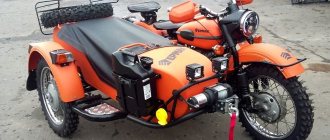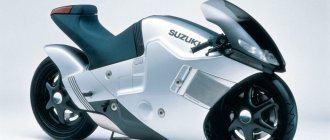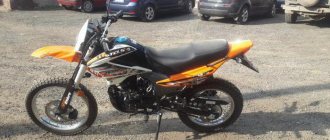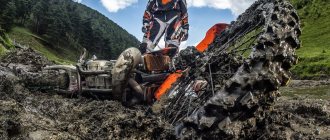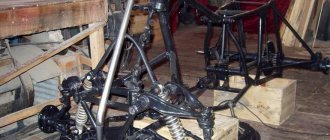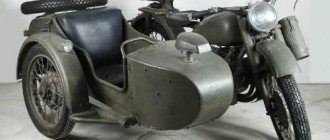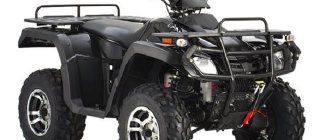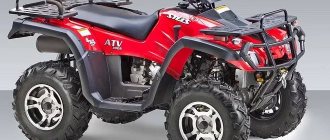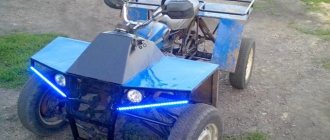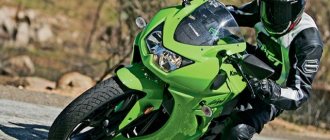This wasn't the first time I'd been asked about this topic, so I decided it was easier to write once than to tell it every time. I will try to briefly and clearly talk about the main types of main and “drive” gears of Soviet-Russian motorcycles with a sidecar.
Let's start with the terms.
The final drive is the mechanism used to transmit torque to the drive wheels (see Figure). this is the “rear axle”, this is the “drive axle”.
Differential (differential mechanism) is a mechanism that causes two wheels to rotate in such a way that the angular speeds of rotation of both wheels may differ from each other and their relationship may be unstable. Explanatory video:
Next, we will consider the four main types of final drive. (We do not consider alterations, rare items and other exotic items). We'll rank the options in ascending order of "asking price." Like.
1. Final drive without wheelchair guide. A motorcycle with such a gearbox has only one drive wheel - the rear one. The stroller wheel rotates freely. Pros: Best of all handling options (allows you to perform a full range of wheelchair tricks in the right hands). Simple design. Less weight and fuel consumption compared to version 2-4. Cons: low cross-country ability. In loose soil or swamps, the wheel quickly digs into the sand and may slip. The stroller gets stuck in the snow.”
2. Simple differential. Installed on motorcycles MV-750M, MV-650, Dnepr-12, Dner-16. The motorcycle with this GPU has two-wheel drive. The rear wheels and sidecar wheels are driven through a constantly engaged differential. Pros: great maneuverability on loose soil, sand and snow. Good handling (even in road traffic). It is easier to go around right turns because the stroller does not inflate, as in options 1 and 4. Cons: The main drawback is in the differential mechanism; more torque is transmitted to the wheel, which turns easier (see Video). Therefore, if one wheel starts to slip or gets stuck in the air, all the momentum will go to it, and the other wheel will stop. In addition, the presence of a wheelchair rail increases weight, design complexity and fuel consumption.
3. Differential is locked. Installed on the MV-750 motorcycle. Older version (compared to simple D.). Failed due to the appearance of reverse. It differs from simple D by the presence of a locking mechanism. When the differential is locked, both wheels rotate together as if they were on the same shaft. This eliminates the "major disadvantage of plain D" described above. Pros: Maximum cross-country ability. The ability to choose between maximum cross-country ability (due to handling) and good handling (due to cross-country ability). Disadvantages: When D is locked, steering and handling are significantly impaired. The remaining disadvantages are the same: weight, complexity, high cost.
4. Switchable, non-differential. “Equipment”, “Patrol” and “Patrol-T” are now installed in the Urals.” A motorcycle with such a GPU can ride with either one (rear) drive wheel or two. The wheelchair drive is manually activated as needed and operates rigidly (as if D. is locked). Pros: The most modern option, allowing you to combine most of the benefits of Option 1 and some of Option 3. The ability to choose between maximum controllability (due to background skills) and maximum background skills (due to controllability). Cons: When connecting a wheelchair track, controllability and maneuverability are significantly reduced. Traditionally heavy weight. The design is simpler than options 2-3, but more complex than options. 1. In all conditions (clutched or not), non-differential traction does not provide the same benefits for right-handers as options 2 and 3. When connecting the sidecar drive, the increase in fuel consumption is commensurate with var. 2-3.
General notes for all options: - Off-road and handling issues are VERY significantly offset by driver skill. — The difference in the weight of the decks with the standard “wheelchair” layout does not matter. In most cases, this can be ignored.
It remains to remember that there are other options for all-wheel drive wheelchairs. Homemade products from automobile bridges, differentials from the Irbit plant, automatic differential locking mechanisms using freewheels or viscous clutches, hydraulic drives, etc. But this is already exotic, because they are rare, and their benefits are often questionable.
There's nothing new or different about four-wheel drive motorcycles. They were created a long time ago on similar machines, mainly for participation in rally-type motorcycle racing. First of all, this is due to the fact that such models cope much better with high-speed cornering.
However, unlike four-wheel drive cars, a four-wheel drive motorcycle does not have four-wheel drive on the front wheel. On the most common models of this type from the Yamaha and KTM brands, only 20% of the power is transferred to the front wheel. Christini's company managed to create a bicycle that sends 50 percent of the power to the front wheel, but this significantly increased the weight of the vehicle. What can domestic models oppose to all this? We will now talk about all the advantages and disadvantages of the Ural all-wheel drive motorcycle.
When did the first all-wheel drive moped appear?
The model was first demonstrated in 1924 in Great Britain. For many years he was the only one. And only after almost 3 decades the famous Rokon bike was created. The principle of its operation is based on the transmission of torque to the front wheel through two chains.
Despite the lack of suspension, the bike felt great on rough terrain. The weight of such a machine did not even reach 100 kg. This motorcycle is very popular nowadays.
Video review of the Ural motorcycle with a sidecar:
What about the all-wheel drive Ural?
In principle, such a car was never officially produced. Therefore, it will not be possible to purchase a production model. However, the Russian master managed to independently create the Urals with a guided stroller, which copes well with difficult sections of the road. A radiator from a VAZ 2106, as well as two additional electric fans, are mounted on such a vehicle. You'll also need a 63A battery and some homemade change.
It is worth saying that this version of the unit for the Ural stroller is the most versatile and allows you to achieve excellent capabilities and reliability of the bottom. As a result, many began to inherit and copy such a creation, so now you can see quite a large number of such cars.
Unfortunately, manufacturers do not always listen to the wishes of customers, which is why the Ural motorcycle with a sidecar has not yet entered mass production. Well, perhaps in a few years they will begin to produce it en masse, but for now you should be content with homemade models.
Ural: the main off-road. The phenomenon of Ural motorcycles or the features of two-wheel all-wheel drive
When in the late 30s of the last century the USSR considered a project for the production of heavy motorcycles for the needs of the Soviet army, no one suspected how deep a cultural layer lay in the history of domestic technology. Apparently, the original technical specifications, including the requirement for Ural motorcycles to get there at any cost, still does not allow the plant, despite all the difficulties, to close the workshops forever
Where do the wheels come from?
It is worth noting - and at this point we advise people with high patriotic expectations to take a deep breath - that the Ural motorcycles are not an original Russian product, but a reworked basis of the BMWR-71, which was in service with the Wehrmacht. Five motorcycles of this model were secretly purchased by the government in Sweden, and then transferred to Soviet engineers for study, after which pilot production of military motorcycles was established on the Moscow basis.
At that time, such “adopting the experience of foreign comrades” was in the order of things, and a couple of years later, the American manufacturers Harley-Davidson and Indian, pursuing similar goals for military orders, did the same, and the BMW R-71, which was so successful for the Germans, was again dismantled for cogs. Nowadays, one would be sued even at the stage of coming up with such thoughts that violate patent rights.
Progenitor and ideological inspirer of Soviet engineers BMW R-71
As if there's something bad about it.
Look, the Americans fly into space using the recycled ideas of Tsiolkovsky, Korolev and von Braun - and they don’t suffer at all, not at all, from this.
And I rode a Ural motorcycle when I lived in a village on the coast of Kamchatka. Urals are still in use in those wild places. The car perfectly fulfills its purpose. Sturdy, passable, repairable. Does it break? Yes. Under severe operating conditions, any equipment breaks down if it is not maintained. But for poor villagers in the outback of Russia, a motorcycle with a sidecar is quite an effective and popular transport.
Ural is our brand!
The entire period of serial production of the motorcycle, excluding the first couple of months, can be safely attributed to the so-called Irbit period in the history of the Ural. Just as production was moved at the end of October 1941 to the Urals, to the city of Irbit, it is still located there.
During the entire, as it seemed at that time, temporary military evacuation to Irbitsk, IVZ managed to deliver 9,799 motorcycles to the front.
After the war, it was decided to produce this amount of equipment in just six months, for which a strategic development plan was developed. According to him, export production of Ural began in 1953, reaching its peak in the 70-80s. The main customers were the army and law enforcement agencies, but ordinary people appreciated the applied potential of the bike.
In the same place as the non-breaking Urals.
Added at 18:43
They won't take it anymore. They won't take it for a long time. Even about 10 years ago there was a topic: “and the opposition sat down on their Japanese” - that was exactly the time when the last stubborn adherents abandoned this garbage.
With varying degrees of success, the plant operated quietly until 1992, when it became a joint-stock company, and a little later, bankrupt. Similar falls, revivals, changes of owners and names occurred continuously over the next 20 years. All this time, the quality of Ural brand motorcycles (now in Latin) has never made potential buyers doubt their choice. People leave, the metal rusts, but the harsh character, quite comparable to the “spirit of freedom” of Harley-Davidson, remains.
Advantages and disadvantages of the vehicle
Among the main reasons why the Ural with an outstanding stroller is very popular are:
- excellent background ability (the likelihood of getting stuck somewhere is almost zero);
- good load capacity;
- better management;
- smoother and softer dynamics.
But the Ural all-wheel drive motorcycle also has its drawbacks. Firstly, this is a more complex frame layout. There is also no way to detach the stroller. At the same time, there are clearly more advantages. Especially for those who like to drive on difficult road sections.
Do-it-yourself reverse gearbox: varieties
Every owner, owner of a plot, always wants to process it in the best possible way, but for this he needs to have a good mechanism for processing; small tractor or walk-behind tractor. It can be purchased if sufficient funds are available. What if they don't exist yet? There is an exit!
You can design a mechanical unit yourself—a minitractor—to work in your garden, plot, or field. What is needed for this?
- ability to make a walk-behind tractor;
- machine parts;
- tools for work.
If you need help, then on the Internet you can find a lot of suggestions and tips on how to make a walk-behind tractor with your own hands.
Definition of a gearbox and its purpose
The most important part of the walk-behind tractor is the gearbox. This is the main drive of the entire mechanism with which the agricultural unit operates. It is important for the owner to know that the life of the walk-behind tractor depends on the gearbox, so you need to choose a high-quality, reliable mechanism.
The purpose of the gearbox is to convert and transmit torque, which is generated from a mechanical transmission and thereby makes the machine mechanism work.
Types of gearboxes
There are several types of gearboxes:
Angular reverse gear unit
This is one of the effective gearboxes. Its task is to ensure that the transmission is connected to the engine. The owner can improve the angular gearbox himself, which will help increase the power of the gearbox. The mechanism consists of:
- generator housing;
- flange;
- flange mounting;
- keys and steel washer;
- pulley fastening;
- a pulley that has a V-belt drive;
- rotor shaft;
- flange bearing.
To design a bevel gearbox, you don’t need a lot of knowledge. Even minimal skills in its manufacture are acceptable here.
Description of reduction and gear drive
The reduction gearbox serves to reduce the number of revolutions and maximize power. This type of gearbox is the most reliable and powerful because it has a special cooling system that is used to cool the air, so walk-behind tractors can withstand heavy loads and can perform a variety of functions. When plowing, even large blocks are not an obstacle for them.
A short summary
Therefore, all-wheel drive motorcycles are indispensable for those who often have to navigate difficult road sections. They are characterized by increased maneuverability and reliability. Among our models, the Ural with all-wheel drive stands out here.
Such a vehicle can easily overtake almost any section of the road. However, the bike did not go into mass production, so you should either buy it on the secondary market or upgrade it yourself.
Fantastic video test drive of an all-wheel drive Ural motorcycle:
MAIN GEAR AND TRANSMISSION MECHANISM OF MOTORCYCLE STROLLERS URAL, FAST-PASSING DNEPR
Off-road bikes have extra grip on the sidecar wheel. On a motorcycle. "Dnepr-16" has a wheelchair brake mounted on the right casing of the wheelchair gearbox, as well as a different design of the transverse driveshaft: instead of a rigid pipe, a relatively thin steel rod is used.
The final drive with asymmetrical cylindrical differential is designed based on the final drive that is used without a differential. Cardan transmission (Fig. 4.38),
The gear, its bearings and housing are taken from the base model of the bicycle. The cuff and hood are the same. The groove on the left hub is the same as the base model. All dimensions of the connection between the main gear and the wheel remain unchanged.
Attached to the crankcase is the differential and gearbox, which form the final drive of the off-road motorcycle. The cardan shaft is transverse with two rigid hinges, the main gear is connected to the wheelchair gearbox. The differential consists of the following main parts: a driven gear 8 and a cup 25, forming the differential housing, two hubs 13 and 28 with a ring gear, two wide satellites 7 and two narrow 24 and their 4 axles 5. The differential cup is connected to bevel gears with using two bolts, fixed with bent washers, and two pins pressed into the protrusions of the cup and freely entering the gear hole. These pins center the position of the two parts. Differential parts 6 are located in the engine crankcase 9 (Fig. 4.38). The right hub 28 ends with a splined ring on which the drive gear 29 of the gearbox is located, secured by a retaining ring 1. The drive gear is connected to the driven gear 27, the rod of which is connected via a universal joint to a transverse cardan shaft going to the gear of the stroller gearbox. The main gear housing parts are connected by cardboard gaskets. Maintenance of the main gear and gearbox consists of checking the oil level and replacing it in a timely manner. The oil level is controlled by two-line dipsticks that show the maximum and minimum levels. The oil type and oil change intervals are the same as the base model.
The cardan bearings are lubricated with a syringe through grease nipples screwed into the cross members. To lubricate the bearings, unscrew the caps with a spoke wrench.
It should be remembered that the cap on the main gear side has a left-hand thread, and on the gear side - a right-hand thread. The movable spline joint of the transverse drive shaft with the cardan fork on the main gear side is also lubricated.
Rice. 4.38. Main gear of a motorcycle with side-wheel drive: 1 — retaining ring; 2 — gear cover; 3, 14 — bushings; 4 - cover; 5 — satellite axis; 6 — differential housing; 7 — wide satellite; 8 - bevel gear; 9 — roller bearing; 10 — needle bearing; 11 — crankcase bushing; 12 — crankcase; 13 — left hub; 15 — bearing; 16 bevel gears; 17 - walnut; 18 — wedge bolt; 19 — cardan shaft; 20 - elastic coupling; 21, 31 — protective caps; 22 — cuff; 23, 26, 30 — ball bearings; 24 — narrow satellite; 25 — differential cup; 27 — small driven gear; 28 — right hub; 29 - drive gear
Rice. 4.39. Differential drive of motorcycles "Dnepr-11/16": 1 - bolt, 2 - lock washer; 3, 17, 29 — rollers; 4 — satellite, 5, 11, 25 — bearings; 6 - ring; 7 — bearing nut, 8, 27 — oil seal seal, 9 — output gear; 10, 23 — washers; 12 — differential cup; 13 - parasitic equipment; 14 — satellite axis; 15 — bushing; 16 — driven gear; 18 — retaining ring; 19 — right hub; 20 — spacer sleeve, 21 — needle bearing; 22 — gear; 24, 26 — spring seal; 28 — left hub
Rice. 4.40. Crankcase and differential casings for motorcycles “Dnepr-11/16″: 1.15 — screws; 2 - cover; 3 - gasket; 4 - differential coverage; 5 - gasket; 6 - gasket; 7 - plug; 8 — differential housing; 9 - gasket; 10 - walnut; 11.21 — washers, 12 — pin; 13 — oil tank; 14 — cam bushing; 16 — ventilation plug; 17 — probe; 18 — crankcase; 19 — bushing; 20 — bracket; 22 - bolt; 23 — spring seal; 24 — oil seal clamp; 25 - oil seal cover
Rice. 4.41. Wheelchair gearbox: 1 — wheelchair suspension lever; 2 — driven gear; 3,12,14 - ball bearings; 4, 8, 15 — cuffs; 5 - bushing; 6 — wheel axle of the stroller; 7 — cuff cover; 10 — right cover; 11 - drive gear; 13 — gearbox housing; 16 — wedge bolt; 17 — protective cap; 18 — cardan shaft; 19 - walnut; 20 — left cover; 21 - gasket
Rice. 4.42. Gearbox with torsion shaft for motorcycles “Dnepr-11/16”: 1.22 - nuts; 2 — special washer; 3 - bogie axle; 4, 9, 19, 31, 33 — bearings; 5, 27 — spring seal; 6, 26 — oil seal cuffs; 7 — bushing; 8 — driven gear; 10 - reflector; 11, 21 — cotter pins; 12 — pin, 13 — oiler; 14 — cardan shaft; 15 — cardan pin; 16 — cardan cross member; 17 — cardan ring; 18 — holder ring; 20 — retaining ring; 23 - washing machine; 24 — wedge bolt; 25 — cardan pin; 28 — gear nut; 29 — ring; 30 — adjusting washer; 32 — spacer sleeve; 34 — small gear; 35, 36 — seals; 37 — cardan cap
How to make a stroller wheel drive for a spark plug frame?!
I looked at this design for a long time (https://oppozit.ru/post_98291.html) and decided to implement it on my M62. In general, we will pull the mechanism. But the method for attaching the rear axle is not clear to me.
I'm interested in the opinion of experts in powered wheelchairs, smart turners and simply technically competent comrades on how the rear axle is mounted. And just thoughts on how to implement this plan more competently and with fewer losses.
For my part, upon completion of this project, I will post the complete technical process step by step, in the public domain, with maximum detail.
The goal is to obtain a rigidly connected drive (not permanent) of a stroller wheel, for spark plug suspension, without differential, as simple as possible to manufacture, based on standard components, and as practical as possible.
